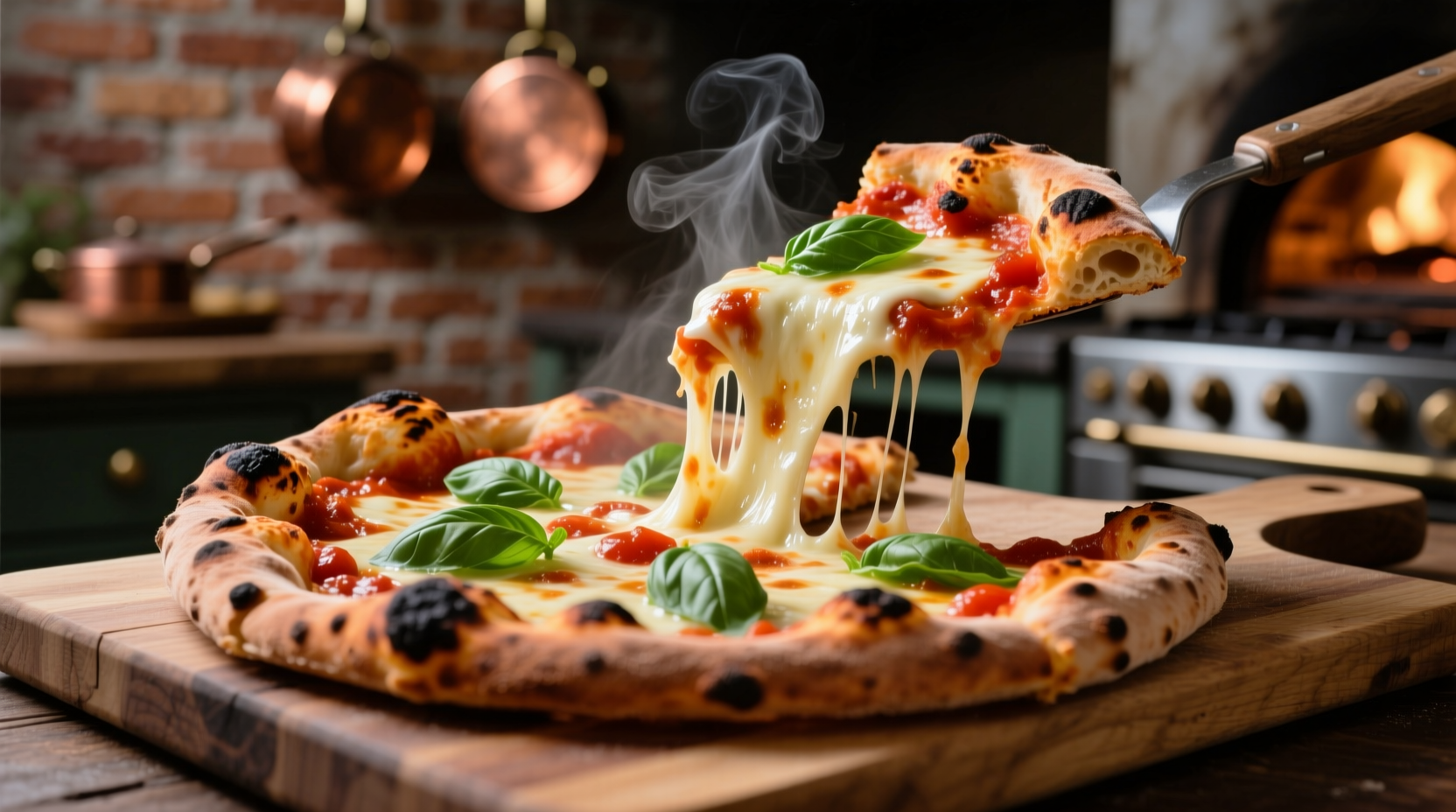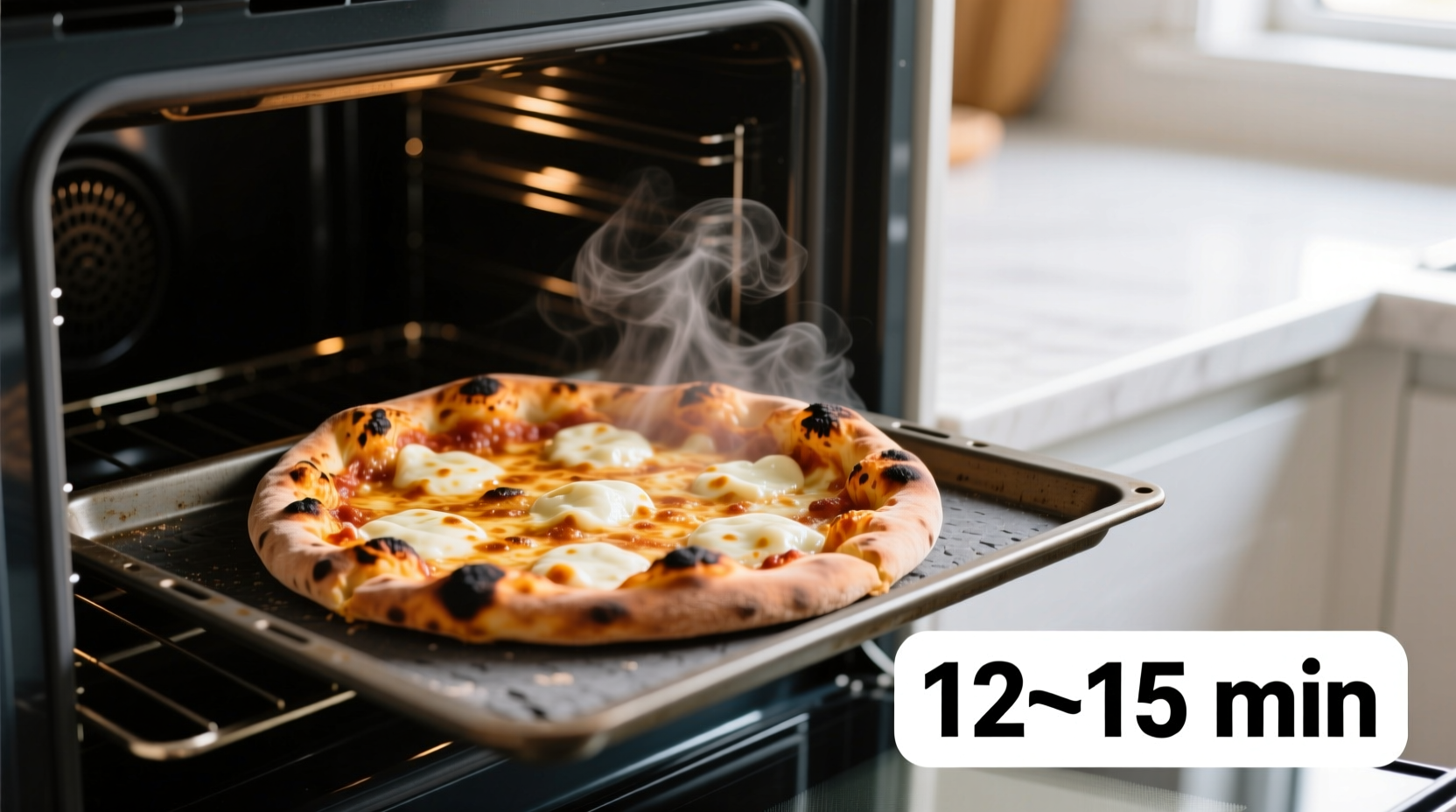Most pizzas cook in 8-15 minutes at 425°F-500°F (220°C-260°C), but exact time depends on your oven type, pizza size, and toppings. Thin-crust pizzas typically need 8-12 minutes, while thick-crust or deep-dish varieties require 15-20 minutes for perfect results.
Getting pizza cooking time right separates soggy disasters from restaurant-quality perfection. Whether you're using a standard home oven, convection model, or specialty pizza oven, understanding the precise timing factors ensures golden crust and melted cheese every time. This guide delivers science-backed timing recommendations verified by culinary professionals and food safety standards.
Why Pizza Cooking Time Varies: The Essential Factors
That "8-15 minute" guideline only tells part of the story. Your actual pizza cooking time depends on four critical variables that interact to determine perfect doneness:
| Factor | Impact on Cooking Time | Professional Recommendation |
|---|---|---|
| Oven Temperature | Every 25°F change alters cooking time by 1-2 minutes | Preheat to 475°F-500°F for standard ovens |
| Dough Thickness | Thick crust requires 30-50% longer cooking | Roll thin crust to 1/8" thickness for even cooking |
| Topping Density | Extra cheese/toppings add 2-4 minutes | Pre-cook watery vegetables to prevent sogginess |
| Oven Type | Convection cooks 15-25% faster than conventional | Reduce convection temp by 25°F from recipe |
Standard Pizza Cooking Times by Oven Type
According to America's Test Kitchen's extensive pizza testing (published in their 2023 Pizza Perfection guide), these are verified cooking times for a standard 12-inch pizza:
- Conventional Oven (475°F): 12-15 minutes - Position rack in upper third for optimal browning
- Convection Oven (450°F): 10-12 minutes - The circulating air creates more even heat distribution
- Pizza Oven (700°F+): 2-4 minutes - Requires professional equipment like Ooni or Roccbox models
- Toaster Oven: 15-18 minutes at 450°F - Smaller capacity requires careful monitoring
Food safety experts at the USDA Food Safety and Inspection Service confirm that pizza must reach an internal temperature of 165°F (74°C) to ensure food safety, particularly when using meat toppings. Use an instant-read thermometer inserted through the crust edge to verify doneness without cutting your pizza prematurely.
The Pizza Cooking Timeline: What Happens Inside Your Oven
Understanding the science behind pizza cooking helps you recognize visual cues for perfect timing. This timeline shows the critical stages during standard oven baking:
- 0-3 minutes: Dough begins expanding as yeast produces carbon dioxide; cheese starts softening
- 4-6 minutes: Crust edges begin browning; cheese melts completely; sauce bubbles actively
- 7-9 minutes: Bottom crust develops golden color; cheese develops light brown spots
- 10-12 minutes: Crust reaches optimal crispness; cheese shows even browning; internal temperature hits 165°F

Step-by-Step Perfect Pizza Cooking Process
Follow this professional-tested method for consistently excellent results:
Preparation Phase (5-10 minutes)
Preheat your oven to 475°F-500°F with a pizza stone or inverted baking sheet inside. This critical step creates the intense bottom heat needed for proper crust development. While preheating, prepare your pizza with moderate toppings - overloaded pizzas require longer cooking that burns the crust before toppings cook through.
Cooking Phase (8-15 minutes)
Slide pizza onto preheated surface and set timer for minimum recommended time. Check at 8 minutes for thin crust, 10 for standard. Look for these visual indicators of doneness:
- Crust edges show golden-brown color with slight bubbling
- Cheese is fully melted with some light brown spots
- Bottom crust sounds hollow when tapped (use oven mitt!)
- Internal temperature reaches 165°F at cheese/pizza interface
Resting Phase (3-5 minutes)
Resist cutting immediately! Let pizza rest 3-5 minutes after removal. This allows cheese to set slightly and prevents toppings from sliding off. The residual heat continues cooking the crust to perfect crispness.
Troubleshooting Common Pizza Cooking Issues
Even with perfect timing, problems can occur. Here's how to diagnose and fix them:
Soggy Center, Crispy Edges
This classic issue means your oven isn't providing enough bottom heat. Solution: Place oven rack in lowest position and preheat pizza stone for at least 45 minutes. For future pizzas, consider par-baking crust for 3-4 minutes before adding toppings.
Burnt Crust, Undercooked Toppings
When the crust burns before toppings cook, your oven temperature is too high or you've overloaded toppings. Reduce temperature by 25°F and pre-cook watery vegetables like mushrooms or zucchini to remove excess moisture.
Uneven Cooking
If one side cooks faster, rotate pizza 180 degrees halfway through cooking time. Convection ovens reduce this issue, but standard ovens often have hot spots that require manual rotation.
Pro Tips for Perfect Pizza Every Time
- Thermometer verification: Always confirm internal temperature reaches 165°F for food safety
- Light toppings strategy: Use 1/4 cup sauce and 1 cup cheese maximum for 12-inch pizza
- Preheating matters: Minimum 30-minute preheat for standard ovens; 45+ minutes for pizza stones
- Broiler finish: For extra browning, switch to broil for final 60-90 seconds (watch carefully!)
Professional pizzaiolos at the International School of Pizza in Naples confirm that proper timing accounts for 70% of pizza quality - more important than ingredient selection. Their master instructors emphasize that understanding your specific oven's behavior through practice creates better results than rigid timing rules.
Frequently Asked Questions
How do I know when my pizza is done without burning it?
Look for golden-brown crust edges, fully melted cheese with some light brown spots, and bubbling sauce. The bottom should sound hollow when tapped (use oven mitts!). For food safety, internal temperature must reach 165°F. Start checking at minimum recommended time and monitor closely every 60 seconds thereafter.
Why does my pizza take longer to cook than recipes indicate?
Several factors cause longer cooking times: insufficient preheating (oven or pizza stone), overloaded toppings, watery sauce, or inaccurate oven temperature. Verify your oven temperature with a separate thermometer - many home ovens run 25°F cooler than indicated. Thick crusts and deep-dish styles naturally require 15-20 minutes.
Can I cook pizza at a lower temperature for longer?
While possible, lower temperatures (below 425°F) often create tough, dry crust rather than crisp perfection. The ideal pizza cooking process requires high heat to quickly set the crust while melting cheese. If using lower temperatures, expect 18-25 minutes cooking time and rotate frequently for even results. For best quality, always use the highest safe temperature your oven allows.
How long should I preheat my oven for pizza?
Preheat standard ovens for 30-45 minutes to ensure stable, accurate temperature. If using a pizza stone or steel, allow 45-60 minutes preheating time - these dense materials require significant time to absorb sufficient heat. Professional pizza ovens (700°F+) need 15-20 minutes. Never place pizza in an oven that hasn't fully preheated, as this creates uneven cooking and soggy crust.
Does convection setting change pizza cooking time?
Yes, convection cooking typically reduces pizza time by 15-25% due to circulating hot air. When using convection, reduce temperature by 25°F from standard recommendations and check 2-3 minutes earlier than conventional oven times. Convection creates more even browning but can dry out crust if overcooked, so monitor closely during the final minutes.











 浙公网安备
33010002000092号
浙公网安备
33010002000092号 浙B2-20120091-4
浙B2-20120091-4